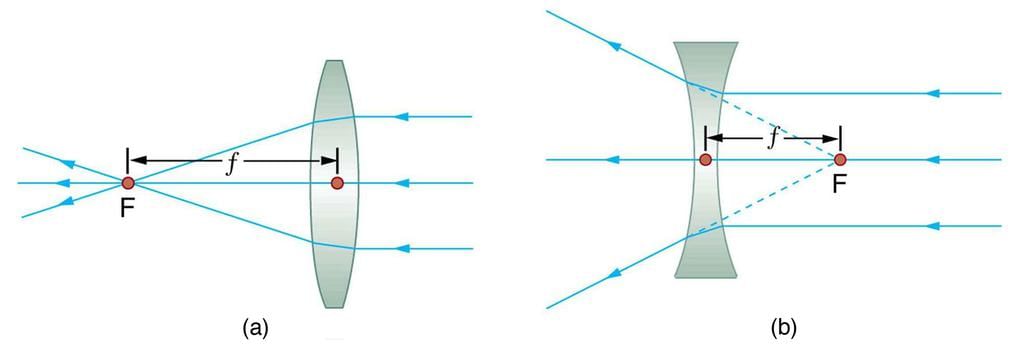Class 10 Exam > Class 10 Questions > Which lens always forms a virtual image ?a)Co...
Start Learning for Free
Which lens always forms a virtual image ?
- a)Concave lens
- b)Convex lens
- c)Converging lens
- d)Both convex and concave
Correct answer is option 'A'. Can you explain this answer?
Most Upvoted Answer
Which lens always forms a virtual image ?a)Concave lensb)Convex lensc)...
Explanation:
A virtual image is an image that cannot be projected onto a screen. It is always located on the opposite side of the lens from the object and is always upright. Virtual images are formed when light rays appear to come from a point behind the lens, rather than actually converging at that point.
Concave Lens:
- A concave lens is thinner at the center and thicker at the edges.
- When light rays pass through a concave lens, they diverge or spread out.
- As a result, a concave lens always forms a virtual image that is upright, smaller in size, and located between the lens and the object.
Convex Lens:
- A convex lens is thicker at the center and thinner at the edges.
- When light rays pass through a convex lens, they converge or come together.
- Depending on the placement of the object, a convex lens can form either a real or virtual image.
Converging Lens:
- A converging lens is another name for a convex lens.
- As discussed above, a converging lens can form both real and virtual images.
Conclusion:
Based on the above explanation, it can be concluded that a concave lens always forms a virtual image.
A virtual image is an image that cannot be projected onto a screen. It is always located on the opposite side of the lens from the object and is always upright. Virtual images are formed when light rays appear to come from a point behind the lens, rather than actually converging at that point.
Concave Lens:
- A concave lens is thinner at the center and thicker at the edges.
- When light rays pass through a concave lens, they diverge or spread out.
- As a result, a concave lens always forms a virtual image that is upright, smaller in size, and located between the lens and the object.
Convex Lens:
- A convex lens is thicker at the center and thinner at the edges.
- When light rays pass through a convex lens, they converge or come together.
- Depending on the placement of the object, a convex lens can form either a real or virtual image.
Converging Lens:
- A converging lens is another name for a convex lens.
- As discussed above, a converging lens can form both real and virtual images.
Conclusion:
Based on the above explanation, it can be concluded that a concave lens always forms a virtual image.
Free Test
FREE
| Start Free Test |
Community Answer
Which lens always forms a virtual image ?a)Concave lensb)Convex lensc)...
Convex (converging) lenses can form either real or virtual images (cases 1 and 2, respectively), whereas concave (diverging) lenses can form only virtual images (always case 3). Real images are always inverted, but they can be either larger or smaller than the object.


|
Explore Courses for Class 10 exam
|

|
Question Description
Which lens always forms a virtual image ?a)Concave lensb)Convex lensc)Converging lensd)Both convex and concaveCorrect answer is option 'A'. Can you explain this answer? for Class 10 2025 is part of Class 10 preparation. The Question and answers have been prepared according to the Class 10 exam syllabus. Information about Which lens always forms a virtual image ?a)Concave lensb)Convex lensc)Converging lensd)Both convex and concaveCorrect answer is option 'A'. Can you explain this answer? covers all topics & solutions for Class 10 2025 Exam. Find important definitions, questions, meanings, examples, exercises and tests below for Which lens always forms a virtual image ?a)Concave lensb)Convex lensc)Converging lensd)Both convex and concaveCorrect answer is option 'A'. Can you explain this answer?.
Which lens always forms a virtual image ?a)Concave lensb)Convex lensc)Converging lensd)Both convex and concaveCorrect answer is option 'A'. Can you explain this answer? for Class 10 2025 is part of Class 10 preparation. The Question and answers have been prepared according to the Class 10 exam syllabus. Information about Which lens always forms a virtual image ?a)Concave lensb)Convex lensc)Converging lensd)Both convex and concaveCorrect answer is option 'A'. Can you explain this answer? covers all topics & solutions for Class 10 2025 Exam. Find important definitions, questions, meanings, examples, exercises and tests below for Which lens always forms a virtual image ?a)Concave lensb)Convex lensc)Converging lensd)Both convex and concaveCorrect answer is option 'A'. Can you explain this answer?.
Solutions for Which lens always forms a virtual image ?a)Concave lensb)Convex lensc)Converging lensd)Both convex and concaveCorrect answer is option 'A'. Can you explain this answer? in English & in Hindi are available as part of our courses for Class 10.
Download more important topics, notes, lectures and mock test series for Class 10 Exam by signing up for free.
Here you can find the meaning of Which lens always forms a virtual image ?a)Concave lensb)Convex lensc)Converging lensd)Both convex and concaveCorrect answer is option 'A'. Can you explain this answer? defined & explained in the simplest way possible. Besides giving the explanation of
Which lens always forms a virtual image ?a)Concave lensb)Convex lensc)Converging lensd)Both convex and concaveCorrect answer is option 'A'. Can you explain this answer?, a detailed solution for Which lens always forms a virtual image ?a)Concave lensb)Convex lensc)Converging lensd)Both convex and concaveCorrect answer is option 'A'. Can you explain this answer? has been provided alongside types of Which lens always forms a virtual image ?a)Concave lensb)Convex lensc)Converging lensd)Both convex and concaveCorrect answer is option 'A'. Can you explain this answer? theory, EduRev gives you an
ample number of questions to practice Which lens always forms a virtual image ?a)Concave lensb)Convex lensc)Converging lensd)Both convex and concaveCorrect answer is option 'A'. Can you explain this answer? tests, examples and also practice Class 10 tests.

|
Explore Courses for Class 10 exam
|

|
Signup for Free!
Signup to see your scores go up within 7 days! Learn & Practice with 1000+ FREE Notes, Videos & Tests.



















